
Sir William Chambers was a Swedish-Scottish architect, based in London. Among his best-known works are Somerset House, and the pagoda at Kew. Chambers was a founder member of the Royal Academy.
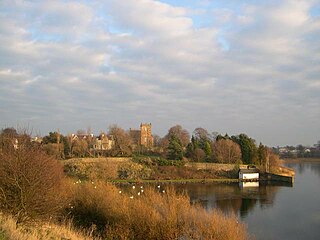
Duddingston is a historic village in the east of Edinburgh, Scotland, next to Holyrood Park.
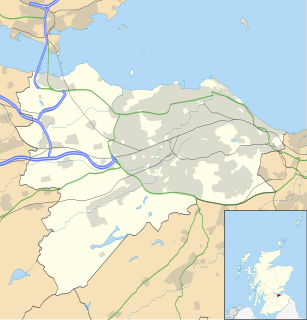
Brunstane is a northeastern suburb of the city of Edinburgh, Scotland. It lies on the A1 and is served by Brunstane railway station on the Borders Railway. Brunstane partly consists of new housing, such as the Gilberstoun estate, and also contains the 1950s council housing schemes known as Magdalene and the Christians, which are south and north of Milton Road respectively.
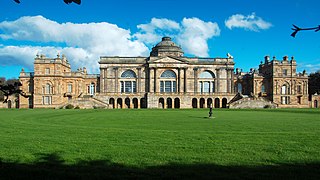
Gosford House is a neoclassical country house around 2 miles (3 km) northeast of Longniddry in East Lothian, Scotland, on the A198 Aberlady Road, in 5,000 acres (2,000 ha) of parkland and coast.
James Hamilton, 2nd Earl of Abercorn was a Catholic Scottish nobleman. He, his wife, his mother, and most of his family were persecuted by the kirk as recusants. Implementing his father's will, he gave his Irish title of Baron Hamilton of Strabane to his younger brother Claud. His younger brothers inherited his father's Irish lands, while he received the Scottish ones, which he squandered away, being deep in debt in his later days.

James Hamilton, 8th Earl of Abercorn PC (Ire), styled Lord Paisley from 1734 to 1736, was a Scottish and Irish peer. He inherited large estates in Ireland, where he built a mansion, and re-acquired some of the family's ancestral lands in Scotland.

Eglinton Castle was a large Gothic castellated mansion in Kilwinning, North Ayrshire, Scotland.
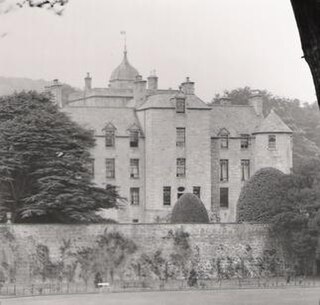
Haltoun House, or Hatton House, was a Scottish baronial mansion set in a park, with extensive estates in the vicinity of Ratho, in the west of Edinburgh City Council area, Scotland. It was formerly in Midlothian, and it was extensively photographed by Country Life in September 1911.
Andrew Fletcher, Lord Milton was a notable Scottish judge and Lord Justice Clerk.

Redhouse Castle is a ruined tower house castle, 2 km east of Longniddry, East Lothian, Scotland, UK, on the B1377, close to Spittal. The castle designated as a scheduled monument. It is no longer protected as a category A listed building.

Milton Hall near Peterborough, is the largest private house in Cambridgeshire, England. As part of the Soke of Peterborough, it was formerly part of Northamptonshire. It dates from 1594, being the historical home of the Fitzwilliam family, and is situated in an extensive park in which some original oak trees from an earlier Tudor deer park survive. The house is a Grade I listed building; the garden is Grade II*.
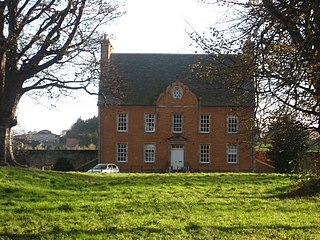
Bankton House is a late 17th-century house situated south of Prestonpans in East Lothian, Scotland. The house is located between the A1 road and the East Coast Main Line railway at grid reference NT394736.

Dalzell House is a historic house in Motherwell, North Lanarkshire, Scotland. It is located to the south of the town, on the north bank of the River Clyde. At its core is a 15th-century tower house, with extensive additions built during the 17th and 19th centuries. In the 1980s the house was restored and divided for sale as eighteen private apartments, while the surrounding Dalzell estate is now owned by North Lanarkshire Council. The house is protected as a Category A listed building, and the grounds are listed on the Inventory of Gardens and Designed Landscapes in Scotland.

Preston Hall, or Prestonhall, is a late-18th-century mansion in Midlothian, to the south of Edinburgh, Scotland. It is located 1.5 kilometres (0.93 mi) north of Pathhead on the east side of the Tyne Water, opposite Oxenfoord Castle on the west side. The house, together with several estate buildings, are the work of architect Robert Mitchell, and are protected as Category A listed buildings, the highest level of protection for a historic building in Scotland.

Balcarres House lies 1km north of the village of Colinsburgh, in the East Neuk of Fife, in eastern Scotland. It is centred on a mansion built in 1595 by John Lindsay (1552–1598), second son of David, 9th Earl of Crawford. The house became the family seat of the Earl of Crawford. The present house is the result of substantial extensions in the early nineteenth century, using part of a fortune made in India, but preserves much of the original mansion.
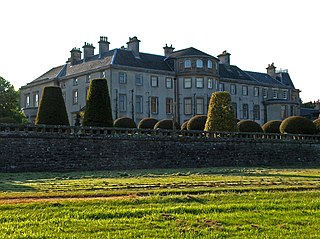
Keir House is a large country house near Stirling in central Scotland. It is located in the parish of Lecropt, 2.5 kilometres (1.6 mi) north-west of Bridge of Allan, in the former county of Perthshire. The estate was home to the Stirling family from the 15th to the 20th century. Keir House is protected as a category A listed building, and the grounds are included on the Inventory of Gardens and Designed Landscapes in Scotland, the national listing of significant gardens.

Tarbat House is a Category A listed building in the Highland council area of northern Scotland. A three-story stone mansion in the neoclassical style, it was built in 1787 by the Edinburgh architect James McLeran for John Mackenzie, Lord MacLeod. The house is located approximately 500m from the village of Milton near Invergordon.

Daylesford House is a Georgian country house near Daylesford, Gloucestershire, on the north bank of the River Evenlode near the border with Oxfordshire. It is about 5 miles (8.0 km) east of Stow-on-the-Wold and 5 miles (8.0 km) west of Chipping Norton. The village of Daylesford lies nearby to the west, Adlestrop to the north, Cornwell to the east, and Kingham to the south,

Newliston is a country house near Edinburgh, Scotland. It is located 1 mile (1.6 km) south-west of Kirkliston, and 8 miles (13 km) west of the city centre. The house, designed by Robert Adam in the late 18th century, is a category A listed building. The 18th-century gardens, inspired by the French formal style, are included in the Inventory of Gardens and Designed Landscapes in Scotland, the listing of nationally significant gardens. Newliston is within the City of Edinburgh council area and the historic county of West Lothian.

Baronscourt, Barons-Court or Baronscourt Castle is a Georgian country house and estate 4.5 km southwest of Newtownstewart in County Tyrone, Northern Ireland, and is the seat of the Duke of Abercorn. It is a Grade A-listed building.



















